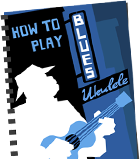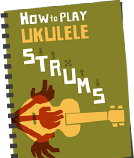Not my usual uke-centric post this. But it’s an issue that affects anyone who has learned a song from the net, made a ukulele video for YouTube, written up a chord chart for a ukulele group or just attempted to learn an instrument.
There’s a lot of debate over copyright when it comes to making videos and putting up chords and tabs. But very little of it focuses on what I think is the biggest issue: the increasing length of copyright.
I have a dog on both sides of this fight. I rely on public domain work for my ebooks (and the actual book I’m working on). But the books themselves are protected by copyright. As I’ve gone along I’ve been learning more and more about copyright and the public domain. And the more I’ve learned the more unfair it seems. So here are a few things I’ve learned along the way that I think are worth considering.
Disclaimer: I’m not a lawyer and I don’t even look like one when I put a suit on.
Copyright Law As It Stands (Sort of)
Like every area of the law, copyright is a bit of mess. Bits have been tacked on and patched up and there are some differences between countries (though they’re converging). But in general, when a person or company makes something (books, songs, music recordings, films) they have the sole rights to it for a certain period of time. After that, it moves into the public domain and anyone can use it however they like. So you can legally tab out a public domain tune and sell it, you can take a public domain video and put your own music to it, you can paint yourself into the Mona Lisa or you can rewrite a story and make a film of it.
The last bit of patch-up of the law in the US was the Copyright Term Extension Act (CTEA) in 1998. This extended the length of copyright from 75 years to 95 years (for corporate works such as Disney film) or 50 years after the death of the creator (making it similar to the laws in Europe).
The act was retrospective, so anything that was still under copyright had its copyright extended. That means nothing has entered the public domain in the US since 1998 and won’t until 2018. If the pre-1998 laws still applied ukulele classics like Five Foot Two and Ain’t She Sweet would be public domain.
Patents and Why They Expire
Coming up with a new invention can take years of research and cost piles. So when someone comes up with a new invention the government gives them the sole right to use it so they can make their money back and then some. If they weren’t allowed to cash in on it, there’d be a lot fewer inventions and we’d all be worse off.
But after 20 years (mostly) patents expire. They need to. Because new inventions always build on old ones and every creative person stands on the shoulders of giants.
Good Stuff That’s Happened Because of the Public Domain
We need copyright for the same reason we need patents: so people keep coming up with new stuff. But – like patents – books, songs, films are built upon to create new uses. The first three re-uses of public domain material that pop into my head:
– Bob Dylan took this and turned it into this.
– Disney films built on stories collected by the Brothers Grimm: Snow White, Sleeping Beauty, Cinderella and The Princess and the Frog.
– Eliza Doolittle took this and turned out this.
There are plenty more (and better) examples. But I think all three demonstrate how creativity isn’t just the person who comes up with the initial idea.
Also, like patents, people learn from the creative works that have gone before. Hands up anyone who has learnt to play the ukulele without once learning a song that’s under copyright.
It’s an interesting comparison between patents and copyright. If 20 years worth of protection is enough to encourage multinationals to pour millions into research, is it really the case that a shirtless indie-boy will be unwilling to write a song unless it’s going to carry on making money until his grandchildren’s generation?
The Evidence
Some very smart people have looked into this issue. When the CTEA was proposed in 1998 a group of economists (amongst them five nobel prize winners including Milton Friedman) investigated and wrote The Copyright Term Extension Act of 1998: An Economic Analysis. Not being ones to hide the lead, the first part of the report is:
It is highly unlikely that the economic benefits from copyright extension under the CTEA outweigh the costs
You can judge the overall thrust of the report from that. But if you want to delve into it, it’s a short, easy read considering it was written by economists.
Also well worth a read is Chapter 9 of James Boyle’s The Public Domain which covers the European Commission’s evaluation of database copyright (stuff like phonebooks where data is collected). The EC were worried that the US database industry (which has no copyright protection) was much more vibrant than Europe’s. So they gave European’s greater database protection. The report looked into whether that change helped – it didn’t.
In the UK sound recordings, unlike most countries and most other forms of work, are only protect for 50 years (from the time of creation). A few musicians got up a campaign about this and Gordon Brown launched the Gowers Review of Intellectual Property (it’s got some good stuff in it, but I don’t recommend plowing through that one). They concluded that, while the current law should be more firmly enforced, the shorter protection doesn’t restrict creativity compared to countries with longer terms.
Why It Should Change
Copyright needs to strike a balance between the return an artist rightly deserves for their work and the right of society to its own culture. Of course, if you create something rad-tacular you absolutely deserve to your jacuzzi full of supermodels. But at the moment, the balance is way out of whack.
The continued extension of copyright has been justified by the increase in life expectancy. I think that’s entirely the wrong way of looking at it. What needs to be acknowledged is the increasing speed that ideas are being built on recycled and improved on. The speed of innovation now is so much quicker than it was when copyright first came into use. And the speed with which art is assimilated, remixed and re-imagined is similarly quick.
Because the law hasn’t kept up with this change of pace (and has gone in the opposite direction), people are starved of their culture. A copyright term of 95 years means the public domain is outside of living memory. And when there’s such a large gap between the time of creation and the ability to develop it, it stagnates. It doesn’t feel right that we don’t have any direct access to art created in our lifetime. And when people feel the law is unjust, they don’t follow it. Here’s what the Gowers Review said (3.26):
Copyright in the UK presently suffers from a marked lack of public legitimacy. It is perceived to be overly restrictive, with little guilt or sanction associated with infringement. While the law is complex, this is not principally a problem of coherence, but of a lack of flexibility to accommodate certain uses of protected material that a large proportion of the population regards as legitimate and which do not damage the interests of rights holders.
There needs to be more of a trade-off between respecting copyright and an extensive and fresh public domain. It’s a trade-off picked up in this article in The Economist. They recommend a 14 year term renewable once (the same terms as the first ever copyright law from 1710) in return for greater protection of those works that remain copyrighted.
I could live with that deal. In fact I’ll say right now, if I’m not writing about ukuleles 14 years hence I’ll make the ebooks public domain. If I am, the ebooks will get there after 28 years.
Actual Clever People
There’s loads more I wanted to say in this post – like orphan work, renewable extensions, how stupid retroactive changes are and It’s A Wonderful Life – but it’s on the long side as it is. If you want to find out more from people who are actually clever, check out:
– Free Culture by Larry Lessig and his TED talk.
– The Public Domain by James Boyle and this talk by Jennifer Jenkins who co-authored Theft! A History of Music with him.




